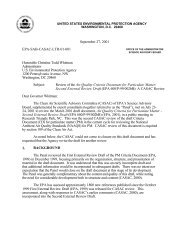Biological Aspects of Hybrid Poplar Cultivation on Floodplains in ...
Biological Aspects of Hybrid Poplar Cultivation on Floodplains in ...
Biological Aspects of Hybrid Poplar Cultivation on Floodplains in ...
Create successful ePaper yourself
Turn your PDF publications into a flip-book with our unique Google optimized e-Paper software.
<str<strong>on</strong>g>Biological</str<strong>on</strong>g> <str<strong>on</strong>g>Aspects</str<strong>on</strong>g> <str<strong>on</strong>g>of</str<strong>on</strong>g> <str<strong>on</strong>g>Hybrid</str<strong>on</strong>g> <str<strong>on</strong>g>Poplar</str<strong>on</strong>g> <str<strong>on</strong>g>Cultivati<strong>on</strong></str<strong>on</strong>g> <strong>on</strong> <strong>Floodpla<strong>in</strong>s</strong> <strong>in</strong> Western North America -- A ReviewBCDAGEFFigure 8.Comm<strong>on</strong> leaf forms associated with <strong>in</strong>terspecificcrosses between P. trichocarpa (female) and P.deltoides (male). Large F 1hybrid leaves (B-F) arerelated <strong>in</strong> part to the large cell size <strong>in</strong>herited from P.trichocarpa (A) and the high cell density from P.deltoides (G). The undersurface <str<strong>on</strong>g>of</str<strong>on</strong>g> aneuploid andtriploid hybrid leaves (B-D) is much lighter thandiploid hybrid leaves (E and F). This lighter color iscorrelated with higher stomatal density and rates <str<strong>on</strong>g>of</str<strong>on</strong>g>water loss. (Photo by R.F. Stettler)The agr<strong>on</strong>omic <strong>in</strong>terest <strong>in</strong> hybrid poplars arisesfrom their rapid juvenile growth and producti<strong>on</strong> <str<strong>on</strong>g>of</str<strong>on</strong>g>woody biomass (Figure 9, Stettler et al. 1988,Ceulemans et al. 1992, Heilman and Xie 1993, 1994).Emphasis <strong>on</strong> the early part <str<strong>on</strong>g>of</str<strong>on</strong>g> their life cycle and <strong>on</strong>favorable cultural c<strong>on</strong>diti<strong>on</strong>s (i.e. high nutrients,irrigati<strong>on</strong> and c<strong>on</strong>trol <str<strong>on</strong>g>of</str<strong>on</strong>g> weedy and herbivorous pests)has promoted the selecti<strong>on</strong> <str<strong>on</strong>g>of</str<strong>on</strong>g> rapid-grow<strong>in</strong>g genotypes.The ease with which poplars can be propagatedvegetatively (i.e. cl<strong>on</strong>ed), allows the selecti<strong>on</strong> <str<strong>on</strong>g>of</str<strong>on</strong>g> the bestperform<strong>in</strong>g genotypes and/or cultivars, such as columnarforms <str<strong>on</strong>g>of</str<strong>on</strong>g> white poplar and Lombardy poplar. Selectivebreed<strong>in</strong>g comb<strong>in</strong>ed with cl<strong>on</strong>al propagati<strong>on</strong> thus enablesthe widespread cultivati<strong>on</strong> and perpetuati<strong>on</strong> <str<strong>on</strong>g>of</str<strong>on</strong>g> desirablehybrid cultivars (Stettler et. al 1996b).The biological c<strong>on</strong>sequences aris<strong>in</strong>g from theartificial breed<strong>in</strong>g and selecti<strong>on</strong> <str<strong>on</strong>g>of</str<strong>on</strong>g> hybrid poplars aremany. Of particular <strong>in</strong>terest to their cultivati<strong>on</strong> <strong>in</strong>floodpla<strong>in</strong> habitats, are those related to decl<strong>in</strong>es <strong>in</strong>reproductive fitness (Bis<str<strong>on</strong>g>of</str<strong>on</strong>g>fi and Gullberg 1996, Stant<strong>on</strong>and Villar 1996, Stettler et al. 1996b, Zsuffa et al. 1996)and reduced resource allocati<strong>on</strong> to defense mechanisms(Newcombe 1996, Floate and Whitham 1993, Floate etal. 1993, Whitham et al. 1996). Defense aga<strong>in</strong>st <strong>in</strong>sectsand pathogens is primarily a functi<strong>on</strong> <str<strong>on</strong>g>of</str<strong>on</strong>g> quantitative andqualitative variati<strong>on</strong> <strong>in</strong> biochemical traits. Interspecificcrosses can result <strong>in</strong> F 1genotypes that are moresusceptible to <strong>in</strong>sect and pathogen attack than parentalspecies. This reducti<strong>on</strong> <strong>in</strong> defense mechanisms is knownas “hybrid breakdown” and has been observed <strong>in</strong> hybridsgrow<strong>in</strong>g <strong>in</strong> commercial plantati<strong>on</strong>s and natural z<strong>on</strong>es <str<strong>on</strong>g>of</str<strong>on</strong>g>hybridizati<strong>on</strong> (Floate and Whitham 1993, 1994, Floate etal. 1996, 1998, Newcombe 1996, Whitham et al. 1996).Figure 9.Harvest <str<strong>on</strong>g>of</str<strong>on</strong>g> seven year old hybrid poplars al<strong>on</strong>g thelower Columbia River. The harvest rotati<strong>on</strong> <str<strong>on</strong>g>of</str<strong>on</strong>g>hybrid poplars is comm<strong>on</strong>ly seven to eight years forthe purposes <str<strong>on</strong>g>of</str<strong>on</strong>g> fiber producti<strong>on</strong>. The producti<strong>on</strong> <str<strong>on</strong>g>of</str<strong>on</strong>g>veneer logs for solid wood products would requireapproximately 12 to 18 years <strong>in</strong> most regi<strong>on</strong>s.(Photo by J.H. Braatne)Thus, whereas hybrid poplars have been bred andselected to grow extremely well under managedc<strong>on</strong>diti<strong>on</strong>s (i.e. with irrigati<strong>on</strong>, fertilizati<strong>on</strong> and pestc<strong>on</strong>trol), they may face significant challenges fromcompetitive <strong>in</strong>teracti<strong>on</strong>s and pathogen attack <strong>in</strong> naturalriparian corridors (Stettler et al. 1996b). Factors relatedto lower reproductive fitness are discussed below.IV.Reproductive properties <str<strong>on</strong>g>of</str<strong>on</strong>g> nativecott<strong>on</strong>woods and hybrid poplarsPopulus species are predom<strong>in</strong>antly dioecious; thus<strong>in</strong>dividual trees are either male (Figure 10a) or female(Figure 10b). The age <str<strong>on</strong>g>of</str<strong>on</strong>g> reproductive maturity variesam<strong>on</strong>g native species from five to ten years, yet <strong>in</strong> somenatural populati<strong>on</strong>s may not occur until the trees are 15to 20 years old (Hort<strong>on</strong> et al. 1960, Fenner et al. 1984,6.
















